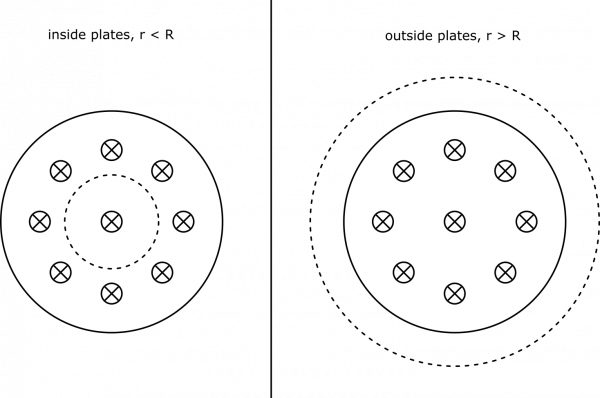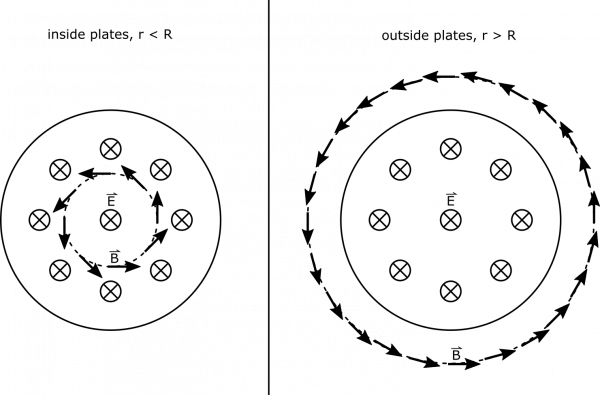This is an old revision of the document!
Changing Current Induces Voltage in Rectangular Loop
Suppose you have an increasing current through a long wire, $I(t) = I_0 \frac{t}{t_0}$. Next to this wire, there is a rectangular loop of width $w$ and height $h$. The side of the rectangle is aligned parallel to the wire so that the rectangle is a distance $d$ from the wire, and they are both in the same plane. What is the induced voltage in the rectangle? In what direction is the induced current in the rectangle?
Facts
- The current in the long wire increases with time and is $I(t) = I_0 \frac{t}{t_0}$.
- The rectangle has dimensions $w$ by $h$, and a side with length $h$ is parallel to the wire.
- The rectangle and the wire lie in the same plane, and are separated by a distance $d$.
Lacking
- $V_{ind}$.
- Direction of $I_{ind}$.
Approximations & Assumptions
- The long wire is infinitely long and thin and straight.
- There are no external contributions to the B-field.
Representations
- We represent the magnetic field from a very long straight wire as $$B = \frac{\mu_0 I}{2 \pi r}$$ where direction is determined based on the right hand rule
- We represent magnetic flux as $$\Phi_B = \int \vec{B} \bullet \text{d}\vec{A}$$
- We can represent induced voltage as $$V_{ind} = -\frac{\text{d}\Phi}{\text{d}t}$$
- We represent the situation with the following visual. We arbitrarily choose a direction for the current.
Solution
We wish to find the magnetic field in the plane we've shown in the representations. Due to the circular symmetry of the problem, we choose a circular loop in which to situate our integral $\int \vec{B}\bullet\text{d}\vec{l}$. We also choose for the loop to be the perimeter of a flat surface, so that the entire thing lies in the plane of interest, and there is no enclosed current (so $I_{enc} = 0$). We show the drawn loop below, split into two cases on the radius of the loop.
Below, we also draw the direction of the magnetic field along the loops. We know the magnetic field is directed along our circular loop – if it pointed in or out a little bit, we may be able to conceive of the closed surface with magnetic flux through it, which would imply the existence of a magnetic monopole. This cannot be the case! We also know that the field is directed counterclockwise, due to the increasing electric field into the page. This comes from an extension of Lenz's Law, upon which discussion is not needed for this course.
We are pretty well set up to simplify our calculation of the integral in the representations, since the B-field is parallel to the loop's perimeter. Below, we show the integral calculation, where the magnetic field at a radius $r$ is displayed as $B(r)$.
$$\int \vec{B} \bullet \text{d}\vec{l} = \int B(r) \text{d}l = B(r) \int \text{d}l = 2\pi r B(r)$$
Next, we need to find the changing electric flux in our loop. Since our loop was described with a flat surface, and the electric field is directed parallel to the area-vector of the loop, we can write electric flux as $\Phi_E = \vec{E} \bullet \vec{A} = EA$. This formula will need to be split up for parts of the surface inside the plates versus outside, since the electric field is different.
$$\Phi_\text{E, in} = EA = \frac{Q/A_{\text{plate}}}{\epsilon_0}A_{\text{loop}} = \frac{Q}{\epsilon_0\pi R^2}\pi r^2 = \frac{Qr^2}{\epsilon_0 R^2}$$ $$\Phi_\text{E, out} = EA = E_\text{in}A_\text{in} + E_\text{out}A_\text{out} = \frac{Q/A_{\text{plate}}}{\epsilon_0}A_{\text{plate}} + 0 = \frac{Q}{\epsilon_0\pi R^2}\pi R^2 = \frac{Q}{\epsilon_0}$$
Now, if we wish the find the change in flux, we will take a time derivative. Notice that all the terms in the flux expressions above are constant, except for $Q$, which is changing with time as dictated by $I$.
$$\frac{\text{d}\Phi_E}{\text{d}t} = \frac{\frac{\text{d}Q}{\text{d}t}r^2}{\epsilon_0 R^2} = \frac{Ir^2}{\epsilon_0 R^2} \text{, inside, } r<R$$ $$\frac{\text{d}\Phi_E}{\text{d}t} = \frac{\frac{\text{d}Q}{\text{d}t}}{\epsilon_0} = \frac{I}{\epsilon_0} \text{, outside, } r>R$$
We can now connect the pieces together (remember, $I_{enc}=0$, so we omit it below). We can write:
$$2\pi r B(r) = \int \vec{B}\bullet \text{d}\vec{l} = \mu_0\epsilon_0\frac{\text{d}\Phi_E}{\text{d}t} = \mu_0 \frac{Ir^2}{R^2} \text{, inside, } r<R$$ $$2\pi r B(r) = \int \vec{B}\bullet \text{d}\vec{l} = \mu_0\epsilon_0\frac{\text{d}\Phi_E}{\text{d}t} = \mu_0 I \text{, outside, } r>R$$
We are ready to write out the magnetic field.
\[ B(r) = \begin{cases} \frac{\mu_0 I r}{2\pi R^2} &&& r<R \\ \frac{\mu_0 I}{2\pi r} &&& r>R \end{cases} \]
Notice, the distance between the plates has no effect on the magnetic field calculation. Also, the amount of the charge on the plates at a given time does not matter – we only care about how fast the charge is changing (the current!). Also, it is interesting that outside the plates, the magnetic field is the same as it would be for a long wire. This would be just as if the capacitor were not there, and the wire were connected. Below, we show a graph of the magnetic field strength as a function of the distance from the center of the capacitor.
We have enough information to find the maximum B-field, which is at the edge of the plates: $$B_{\text{max}} = \frac{\mu_0 I}{2\pi R} = \frac{4\pi \cdot 10^{-7} \text{Tm/A} \cdot 3\text{ A}}{2\pi \cdot 10 \text{ m}} = 60 \text{ nT}$$



